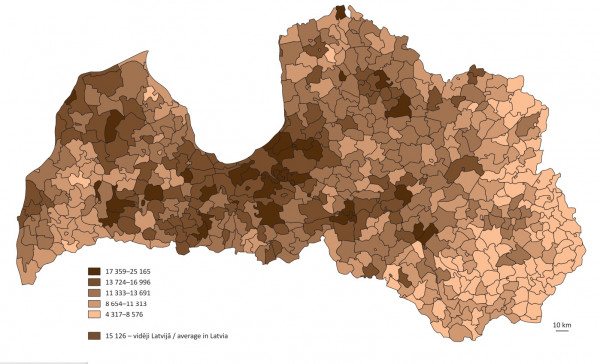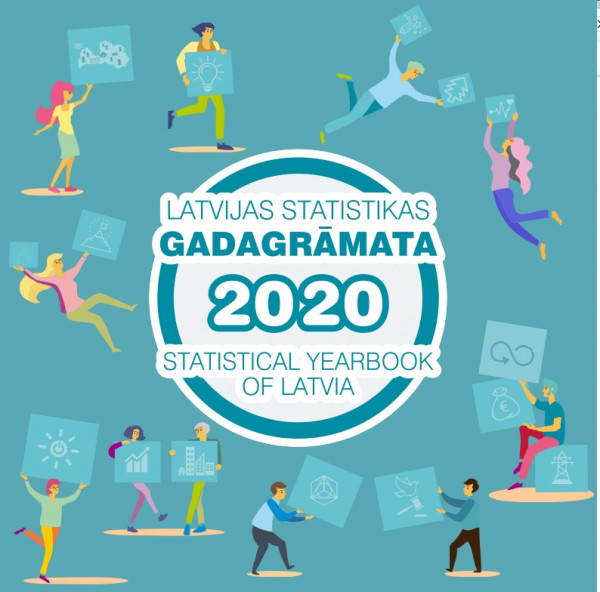The last yearbook of pre-Covid statistics
The Central Statistical Bureau of Latvia has published the Statistical Yearbook of Latvia 2020. It compiles statistics for 2019 and compares them with previous years.
The easy way would be to take the previous year's statistical yearbook and add the most recent year's data to its tables and graphs while excluding older years' data. For key statistical indicators, this approach is logical and is used. However, at the same time, new trends are observed every year, therefore the CSB is improving various ways of obtaining and processing data. Every year there may be topical issues specific to this time. The 2019 edition contained a lot of material on the results of the European elections, which, of course, were not carried over to the latest yearbook.
The Statistical Yearbook of Latvia 2020 includes completely new topics that have not been published in the yearbooks so far. For example, the 2017 map of Latvian administrative units with value added generated by employed population (by actual residence and territorial unit) (p. 38).
On the other hand, the map, which shows the share of population having actual residence in Latvia at the Population and Housing Census 2000 moment and abroad at the beginning of 2020 by territorial unit (%), shows well which parishes have the largest share of emigrants. On average, 12.4% of those registered in Latvia during the 2000 census were living outside Latvia in 2020 (p. 43). As those born after 2000 have also left Latvia during the last twenty years, the total percentage of people moving abroad is even higher.

The yearbook is complemented by maps on population distribution, showing the number of the usually resident population in densely populated areas (at least 50 inhabitants) at the beginning of 2020 (p. 45) and the share of rural population by territorial unit at the beginning of 2020 (p. 46), as well as types of family nuclei (families without children, families with at least one child under 18, families in which the youngest child is already 18 or older) by administrative territory at the beginning of 2020 (p. 58).
The yearbook includes maps with the most popular names of women and men in 2019 in the regions and cities of Latvia, which allows assessing trends. The men are firmly dominated by Aleksandrs and Jānis, but in Riga during the year Tatjana is already ahead of Jeļena. Among women's names, the most common names in Vidzeme are Inese and Līga, in Latgale - Anna, Valentīna and Tatjana, in Kurzeme - Anna, Ilze and Dace (p. 69).
The yearbook contains information on the number of registered religious congregations by denomination at the end of the year (p. 116), which shows that the number of registered congregations for almost all traditional Latvian religions is decreasing. This is understandable, because as the population declines, so must the figures for the population-related topics. There are only two denominations in which the number of registered congregations has increased during the year. The number of Orthodox congregations has increased by three, and there are now two more Old-believer congregations.
Statistics related to inequality are included in the yearbook much more extensively. The yearbook includes additional at-risk-of-poverty or social exclusion indicators (p. 134), the at-risk-of-poverty rate in different socio-economic groups of the population, consumption expenditure in different household types (p. 139), the structure of consumption expenditure, and other indicators.

The new yearbook has a much-expanded section on international comparisons. Of course, many comparisons in terms of GDP per capita, etc. have remained, but finally an indicator has been found in which Latvia is in the first place in the EU, and that is the number of women per 100 men in 2019.
Latvia with the ratio of 117 women per 100 men is in first place in the EU, ahead of Lithuania and Portugal (p. 208). The new yearbook includes international comparisons of the proportion of children born out of wedlock, the average age of a woman at the birth of her first child, and other indicators. As the Statistical Yearbook of Latvia 2020 can be freely downloaded from the CSB website (in the publications section), it will easily find its readers even during these special circumstances.
Statistical Yearbook of Latvia 2020